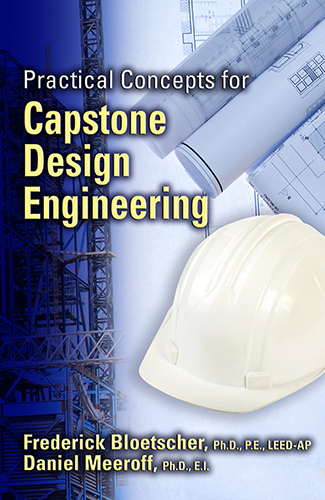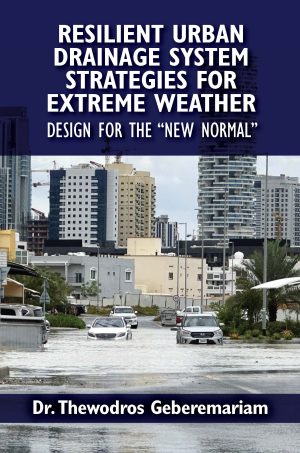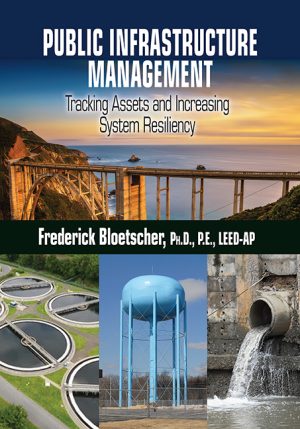Practical Concepts for Capstone Design Engineering
$109.95
By Frederick Bloetscher, Ph.D., P.E., LEED-AP and Daniel Meeroff, Ph.D., E.I.
Hardcover, 7×10, 424 pages
ISBN: 978-1-60427-114-0
July 2015
Description
Practical Concepts for Capstone Design Engineering is the first and only comprehensive senior-level college textbook that provides the essential information needed to complete a successful capstone project in civil, construction, or environmental engineering. The concept for the book is based on replication of the steps commonly used by practicing engineers to complete design projects, from site selection, investigation, and site planning, through the preliminary design calculations and drawing preparation. Students will gain valuable insight and preparation for civil and construction engineering professional practice, and will learn how to smoothly transition from strictly academic work to solving real-world problems in the context of their capstone projects. The authors provide professional quality work examples, case studies, helpful hints, and assignments at the end of each chapter that further enhance comprehension. In addition to providing students with the key skills necessary to successfully enter the profession, they will also be well prepared for the Fundamentals of Engineering Exam upon graduation.
Key Features
- Replicates the steps commonly used by practicing engineers to complete design projects, from site selection, investigation, and site planning, through the preliminary design calculations and drawing preparation
- Offers valuable insight and preparation for civil and construction engineering professional practice
- Transitions students from strictly academic work to solving real-world problems in the context of their capstone projects
- Offers an approach for integrating students, faculty, design professionals, clients, consultants and regulators—bridging the gap between the classroom and the profession
- Students will be well prepared for the Fundamentals of Engineering Exam upon graduation
- WAV™ offers a variety of professor materials including a capstone syllabus, final exam, and instructional slides reviewing concepts presented in the text —available from the Web Added Value™ Download Resource Center
About the author(s)
Frederick Bloetscher, Ph.D., P.E., LEED-AP, is an associate professor at Florida Atlantic University in Boca Raton, Florida, focusing on management of water resources from a holistic perspective. Specific areas of concentration include: surface water, groundwater, stormwater, wastewater and reclaimed sources, and appropriate methods for disposal of wastewater products, including concentrate from membrane treatment plants, the fate of ocean outfall flows, and the concept of sustainable water supplies for communities. Dr. Bloetscher teaches the two-semester capstone design course at FAU, and leads the second semester in which the conceptual design of green building construction is turned into preliminary plans, specifications and basis-of-design reports. In 2012, Dr. Bloetscher, serving as the LEED administrator for the project, along with fellow author and capstone design course professor Dr. Daniel Meeroff, received the National Council of Examiners for Engineering and Surveying (NCEES) Award for Connecting Professional Practice and Education. They were presented with this award in recognition for their work on the Dania Beach Nanofiltration Facility, the first LEED-Gold water treatment facility in the world. Prior to teaching at FAU, Dr. Bloetscher was an adjunct faculty member at the University of Miami in Coral Gables, FL. Throughout his years as a professor, Dr. Bloetscher has been nominated a number of times by his students for Teacher of the Year Award, and has received two University-wide leadership awards.
In addition to his role as an educator, Frederick Bloetscher, a LEED-AP with professional engineering licenses in 9 states, is the President of Public Utility Management and Planning Services, Inc. (PUMPS), a consulting firm dedicated to the comprehensive evaluation of utility systems. Previously he served as Chair for the Water Resource Division Trustees, Groundwater Resource Committee and Education Committee for the American Water Works Association (AWWA), wrote for them several manuals on water and wastewater, and was awarded two national leadership awards from the AWWA. In addition to his work with the AWWA, Mr. Bloetscher also served as the utility director and deputy director for several large water and sewer systems.
Dr. Bloetscher received his bachelor’s degree in civil engineering from the University of Cincinnati, his Master of Public Administration Degree from the University of North Carolina at Chapel Hill and his Ph.D. in civil engineering from the University of Miami.
Daniel E. Meeroff, Ph.D., is associate chair and professor in the Department of Civil, Environmental & Geomatics Engineering at Florida Atlantic University (FAU). Dr. Meeroff specializes in environmental engineering, with a focus on water and wastewater engineering, water chemistry, solid/hazardous waste management, sustainable building strategies, and pollution prevention. Since joining the staff at FAU, Dr. Meeroff has won numerous awards recognizing his teaching abilities, and was also instrumental in developing their innovative and well recognized capstone design program.
Dr. Meeroff co-teaches the capstone design course at FAU, a two-semester, senior-level sequence focused on the planning and conceptual design of green building construction. He also founded and serves as director of the Laboratories for Engineered Environmental Solutions at FAU. In 2014, the Engineer’s Council awarded Dr. Meeroff the Engineering Educator of the Year, and the student body at FAU selected him as the Distinguished Teacher of the Year, the highest teaching honor at the university. In 2011, Dr. Meeroff was selected by the students for the Excellence and Innovation in Undergraduate Teaching Award at FAU, and has been nominated for the Teacher of the Year award numerous times by his students. Daniel Meeroff has also written several substantial laboratory manuals for engineering students on environmental engineering and science, as well as chemistry.
Dr. Meeroff earned his bachelor’s degree in environmental science from Florida Institute of Technology and his master’s and Ph.D. degrees in civil/environmental engineering from the University of Miami.
Table of Contents
Preface
About the Authors
Chapter 1: Introduction to Capstone Design
1.1—The Capstone Design Process
1.2—Course Objectives
1.3—Project Selection
1.4—Cours Management Structure
1.5—Group Selection
1.6—Course Delivery Structure
1.7—Getting Started
1.8—Deliverables
1.9—Assessment
1.10—Last Words
1.11—References
Chapter 2: Career Opportunities and Leadership
2.1—Self-Assessment
2.2—Types of Job Opportunities
2.3—Branding
2.4—Create the Group Design Firm
2.5—Teaming Skills
2.6—References
2.7—Assignments
Chapter 3: The Profession and Ethical Conduct
3.1—Engineering Ethics
3.1.1—Where Do Ethics Come From?
3.1.2—The Philosophers Weigh In
3.1.3—Creeds, Codes and Canons
3.2—Ethical Issues in Engineering
3.2.1—Case Study 1: Licensure in Multiple States
3.2.2—Case Study 2: Practicing Without a License
3.2.3—Case Study 3: Design Defect
3.2.4—Case Study 4: Failing to Seal the Documents
3.2.5—Case Study 5: Sealing Documents That Are Not Final
3.2.6—Case Study 6: Misleading Testimony about a Design
3.3—Licensure
3.4—References
3.5—Assignments
Chapter 4: Getting the Design Contract
4.1—Building the Capital Project
4.2—What Owners (Should) Look For from Consulting Engineers
4.3—What Consultants Do Not Need
4.4—The Typical Public Sector Proposal Process
4.4.1—Scope of the Project
4.4.2—Requirements of Proposers
4.4.3—Evaluation of Proposals
4.5—The Typical Private Sector Proposal Process
4.6—Stages in the Design Process
4.6.1—Conceptual Design
4.6.2—Construction Documents
4.6.3—Scheduling and Project Delivery
4.7—References
4.8—Assignments
Chapter 5: The Art of Communication Skills for Engineers
5.1—The Engineering Writing Style
5.2—Outlining
5.3—Good Grammar
5.4—Citing References
5.4.1—Journal References
5.4.2—Conference Proceedings and Symposiums
5.4.3—Books
5.4.4—Reports
5.4.5—Unpublished Material
5.4.6—Web Pages
5.4.7—Theses and Dissertations
5.5—Writing Persuasively
5.6—Engineering Graphics
5.6.1—Numerical Tables
5.6.2—Figures
5.7—Proofreading Strategies
5.8—Fonts
5.9—Margins
5.10—Typical Engineering Documents
5.10.1—Meeting Minutes
5.10.2—Emails and Informal Notes
5.10.3—Memos
5.10.4—Letters
5.11—Typical Engineering Deliverables
5.11.1—Progress Reports
5.11.2—The Basis of Design Report
5.11.3—Technical Memos
5.11.4—Interim and Final Technical Reports
5.12—Public Speaking
5.12.1—Visual Aids
5.12.2—Questions and Answers
5.12.3—Evaluating Presentations
5.13—References
5.14—Assignments
5.15—Appendix
5.15.1—Grammar
5.15.2—Punctuation
5.15.3—Capitalization
5.15.4—Common Spelling Errors
5.15.5—Misused Words
5.15.6—Abbreviations
5.15.7—Numbers
5.15.8—Figurative Language Use
5.15.9—Voice
5.15.10—Gender Issues
5.15.11—Writing Pitfalls to Avoid
Chapter 6: Alternative Analysis
6.1—Application to Design Projects
6.2—Selection Criteria
6.3—Scoring System
6.4—Alternative Selection Matrix
6.5—Sensitivity Analysis
6.6—References
6.7—Assignments
Chapter 7: High Performance Construction
7.1—Why Build Green?
7.2—Agencies That Valuate Green Building Performance
7.2.1—International Organization for Standardization (ISO)
7.2.2—United States Environmental Protection Agency (USEPA)
7.2.3—United States Green Building Council (USGBC)
7.3—LEED® Certification
7.3.1— Requirements
7.3.1.1—Sustainable Sites
7.3.1.2—Water Efficiency
7.3.1.3—Energy and Atmosphere
7.3.1.4—Materials and Resources
7.3.1.5—Indoor Environmental Quality (IEQ)
7.3.1.6—Innovation and Design Process
7.4—Triple Bottom Line
7.5—References
7.6—Assignments
Chapter 8: Environmental Site Assessment
8.1— Scope
8.2—The Environmental Professional
8.3—Site Reconnaissance
8.3.1—Exterior Reconnaissance
8.3.2—Interior Reconnaissance
8.4—Records Review
8.5—Interviews
8.6—Evaluation and Report
8.7—Non-Scope Considerations
8.8—Phase II and III
8.9—References
8.10—Assignments
Chapter 9: The Site Plan Development Process
9.1—Community Plans and Codes
9.2—Site Development
9.3—Easements, Rights of Way, and Setbacks
9.4—Utilities, Parking Requirements and Roadwork
9.5—Building Code Requirements and Functionality
9.6—Assignments
Chapter 10: The Floor Plan Development Process
10.1—Building Program
10.2—Floor Planning
Chapter 11: Engineering Economics
11.1—Interest Rates
11.2—Single Payment Present Worth
11.3—Future Value or Single Payment Compound Amount
11.4—Annual Worth
11.5—Future Worth Given an Annuity
11.6—Gradients
11.7—Shifted Annuities
11.8—More About Interest Rates
11.9—Dealing with More Complex Cash Flow Diagrams
11.10—Comparing Options
11.10.1—Break Even Analysis
11.10.2—Annual Worth Analysis
11.11— Inflation Adjustment
11.12—Depreciation
11.13—A Word of Caution
11.14—References
11.15—Assignments
Chapter 12: Preliminary Site Design and Non-Structural Concepts
12.1—Roof Systems
12.2—Onsite Stormwater Drainage
12.3—Potable Water Systems
12.4—Sanitary Sewer Systems
12.5—Heating, Ventilation and Air Conditioning (HVAC)
12.6—Parking Considerations
12.7—Landscaping
12.8—Transportation
12.9—References
Chapter 13: Structural Design Concepts
13.1—Load and Resistance Factor Design (LFRD)
13.2—Types of Loads
13.2.1—Dead Loads
13.2.2—Live Loads
13.2.3—Wind Loads
13.2.4—Roof Loads
13.2.5—Rain Loads
13.2.6—Snow Loads
13.2.7—Earthquake Loads
13.2.8—Other Loads
13.3—Structural Design Concepts
13.3.1—Concept of Tributary Area
13.3.2—One-Way and Two-Way Slabs
Example 1: One-Way Slab Design of Flexure Reinforcement
13.3.3—Beams and Girders
Example 2: Design of Continuous Steel Beam for Flexure by LRFD
13.3.4—Columns
Example 3: Design of Steel Columns
13.3.5—Walls
Example 4: Concrete shear wall design
13.3.6—Lateral Load Analysis
13.3.7—Serviceability
13.3.8—Structural Detailing
13.4—Foundation Design Concepts
13.4.1—Shallow Foundations
13.4.2—Strip Footer Foundations
13.4.3—Shallow Footer Foundations
13.4.4—Pile Foundations
13.5—References
Chapter 14: Cost Estimating
14.1—Purpose and Process
14.2—Stages of Cost Estimating
14.3—Bidding Process
14.4—Asset Management
14.5—Life Cycle Analysis
14.6—References
14.7—Assignments
Chapter 15: Conclusion
Reviews
“Until now, there has not been a textbook for civil, construction, and environmental engineering capstone design courses that is as complete as Practical Concepts for Capstone Design Engineering. This book offers great value for professors and students.”
—Sharon C. Long, Professor, University of Wisconsin
“Finding an acceptable design engineering textbook is an incredible challenge; Practical Concepts for Capstone Design Engineering is the text you have been looking for—it will provide students with the applied design knowledge required in today’s civil and construction fields.”—Dr. Steven J. Duranceau, PE, Assoc Professor of Environmental Engineering; Dir. of Environmental Systems Engineering Institute, University of Central Florida
You may also like…
Related products
-

Plasticity for Structural Engineers
Retail Price: $64.95$54.95 Add to cart -

Theory of Beam-Columns, Volume 2
Retail Price: $64.95$54.95 Add to cart -

Transportation Statistics
Retail Price: $119.95$99.95 Add to cart -

Mechanics for Engineers: Statics
Retail Price: $99.95$89.95 Add to cart -

Theory of Beam-Columns, Volume 1
Retail Price: $64.95$54.95 Add to cart






